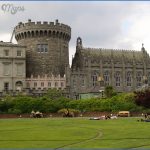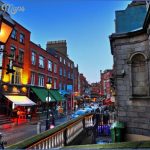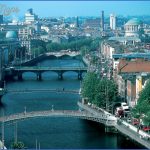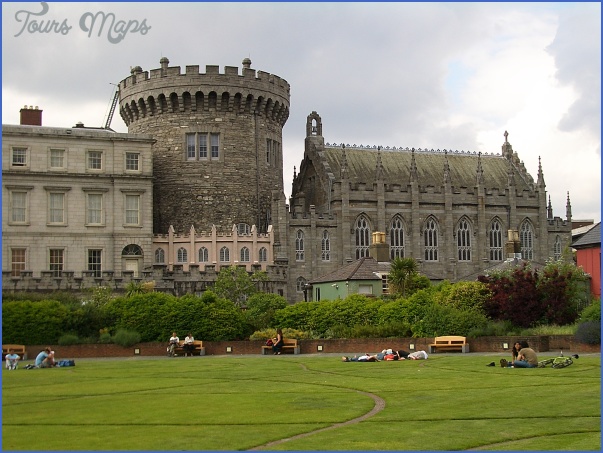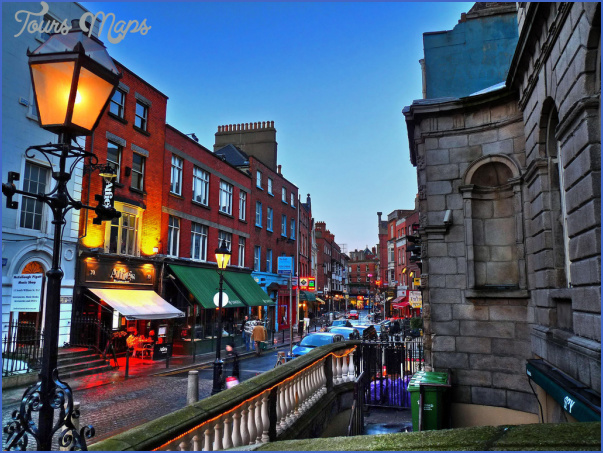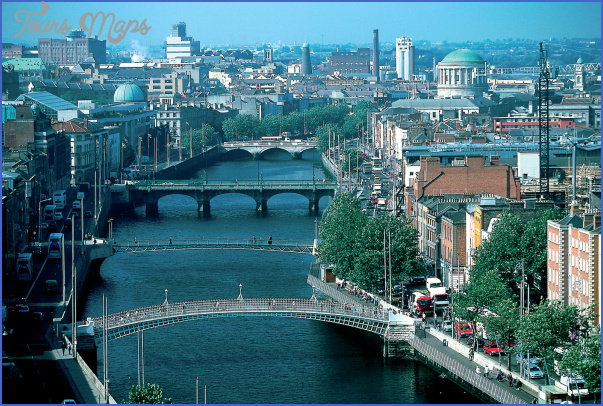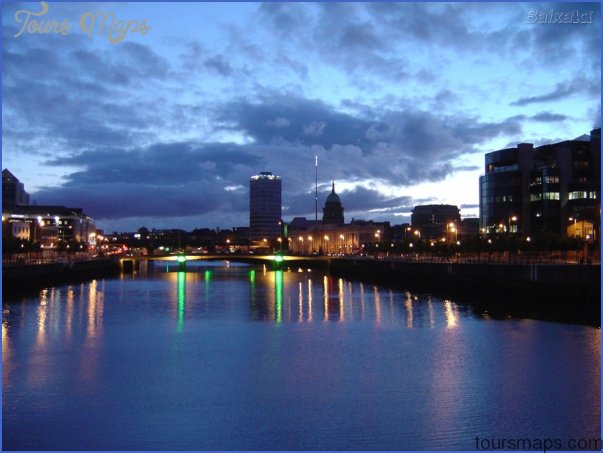DUBLIN
In a country known for its relaxed pace and rural sanctity, Dublin stands out with boundless energy and international flair. The city and its suburbs, home to one-third of Ireland’s population, are at the vanguard of the country’s rapid social evolution. In an effort to stem international and rural emigration, vast portions of the city have undergone renovation and redevelopment, funded by the deep pockets of the EU. Dublin may hardly look like the rustic Emerald Isle promoted in tourist brochures, but its people and history still embody the charm and warmth that have made the country famous.
TRANSPORTATION
Flights: Dublin Airport (DUB; 814 1111). Dublin buses #41, 41B, and 41C run from the airport to Eden Quay in the city center with stops along the way (every 20min. ‚1.60). The Airlink shuttle (844 4265) runs non-stop to Busaras Central Bus Station via O’Connell St. (20-25min. every lOmin. ‚5) and on to Heuston Station (50min. ‚4.50). A taxi to the city center costs roughly ‚15-20.
Trains: The larnrod Eireann travel center, 35 Lower Abbey St. (836 6222; www.irishrail.ie), sells tickets for Irish Rail. (Open M-Sa 9am-6pm, Su 10am-6pm.) Connolly Station, Amiens St. ( 702 2358), is north of the Liffey and close to Busaras Central Bus Station. Buses #20, 20A, and 90 go from the station to destinations south of the river, and the DART (see below) runs to Tara on the south quay. Trains to: Belfast (2hr. 5-8 per day, ‚29); Sligo (3hr. 3-4 per day, ‚22); Wexford (3hr. ‚17). Heuston Station (703 2132) is south of Victoria Quay, west of the city center (25min. walk from Trinity College). Buses #26, 51, 90, and 79 go to the city center. Trains to: Cork (3hr. 6-11 per day, ‚43); Galway (214hr.; 4-5 per day; ‚21, F and Su ‚28); Limerick (2$hr. 9 per day, ‚34); Waterford (2’2hr. 3-4 per day, ‚17). Dublin’s other train station is and Pearse Station, Pearse St. ( 703 3634).
Buses: Info is available at the Dublin Bus Office, 59 O’Connell St. (872 0000); the Bus Eireann window is open M-F 9am-5pm, Sa 10:30am-2pm. Buses arrive at Busaras Central Bus Station (836 6111), on Store St. directly behind the Customs House and next to Connolly Station. Bus Eireann runs to: Belfast (3hr. 6-7 per day, ‚18); Derry (41Ahr. 5-6 per day, ‚18); Donegal Town (4%hr. 5-6 per day, ‚15); Galway (32hr. 13 per day, ‚13); Limerick (3V5hr. 7-13 per day, ‚15); Rosslare Harbour (3hr. 7-10 per day, ‚14); Sligo (4hr. 4-5 per day, ‚14); Waterford (3hr. 10 per day, ‚10); Wexford (2%hr. 7-10 per day, ‚10).
Ferries: Irish Ferries, 2-4 Merrion Row ( 638 3333; www.irishferries.com), is open M- F 9am-5pm, Sa 9:15am-12:45pm. Ferries arrive from Holyhead, UK at the Dublin Port ( 607 5665), from which buses #53 and 53A run every hr. to Busaras station (tickets ‚1). Norse Merchant Ferries also dock at the Dublin Port and run a route to Liverpool, UK (7’2hr.; 1-2 per day; ‚25-40, with car ‚105-170); booking for Norse Merchant is only available from Gerry Feeney, 19 Eden Quay (819 2999). Stena Line ferries arrive from Holyhead at the Dun Laoghaire ferry terminal (204 7777); DART (see below) trains run from Dun Laoghaire to the Dublin city center. Dublin Bus also runs connection buses timed to fit the ferry schedules (‚2.50-3.20).
Public Transportation: Dublin Bus, 59 O’Connell St. (873 4222). Open M 8:30am- 5:30pm, Tu-F 9am-5:30pm, Sa 9am-lpm. The smaller City Imp buses run every 8- 15min. Dublin Bus runs the NiteLink service to the suburbs (M-W at 12:30am and 2am, Th-Sa every 20min. from 12:30am-4:30am; ‚4). Travel Wide passes offer unlimited rides for a day (‚5) or a week (‚18). DART trains serve the suburbs and the coast (every 10- 15min. 6:30am-ll:30pm, ‚0.75-1.70).
Taxis: National Radio Cabs, 40 James St. (677 2222). ‚2.75 plus ‚1.35 per mi. before 10pm, ‚1.80 per mi. after 10pm. ‚1.50 call-in charge.
Car Rental: Budget, 151 Lower Drumcondra Rd. (837 9611), and at the airport. In summer from ‚40 per day, ‚200 per week; off-season ‚38165. 23+.
Bike Rental: Cycle Ways, 185-6 Parnell St. (873 4748). Open M-W and F-Sa 10am- 6pm, Th 10am-8pm. ‚20 per day, ‚80 per week; deposit ‚200.
ORIENTATION AND PRACTICAL INFORMATION
In general, Dublin is refreshingly compact, though navigation is complicated by the ridiculous number of names a street adopts along its way. Street names are usually posted on the side of buildings at most intersections and never on street- level signs. Buying a map with a street index is a smart idea. Collins publishes the invaluable Handy Map of Dublin (‚6.50), available at the tourist office. The Ordnance Survey Dublin Street Map (‚6) is a more detailed, yet heftier, option.
The River Liffey forms a natural boundary between Dublin’s North and South Sides. Heuston Station and the more famous sights, posh stores, and upscale restaurants are on the South Side. Connolly Station and the majority of hostels and the bus station cling to the North Side. The North Side hawks merchandise cheaper than in the more touristed South. It also has the reputation of being rougher, especially after sunset. The streets running alongside the Liffey are called quays (KEYS); each bridge over the river has its own name, and streets change names as they cross. If a street running parallel to the river is split into Upper and Lower, then the Lower is always the part of the street closer to the mouth of the Liffey. O’Connell Street, three blocks west of the Busaras Central Bus Station, is the primary link between north and south Dublin. Henry Street and Mary Street comprise a pedestrian shopping zone that intersects with O’Connell St. after the General Post Office (GPO), two blocks from the Liffey. Fleet Street becomes Temple Bar one block south of the Liffey. Dame Street runs parallel to Temple Bar until Trinity College, which defines the southern edge of the district. Trinity College is the nerve center of Dublin’s cultural activity, with legions of bookshops and student pubs.
DUBLIN Photo Gallery
Maybe You Like Them Too
- Explore Pulau Sebang Malaysia with this Detailed Map
- Explore Southgate, Michigan with this detailed map
- Explore Les Accates, France with this Detailed Map
- Explore Góra Kalwaria, Poland with this detailed map
- Explore Gumdag, Turkmenistan with this detailed map

